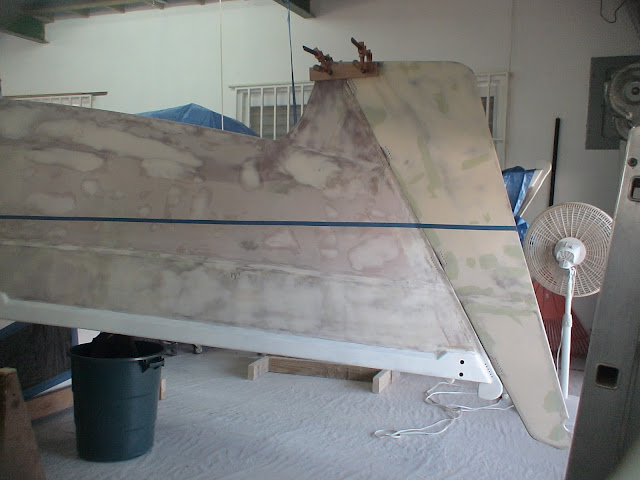This image is late breaking news from the last episode. Here the smoked acrylic portlites are put in place and the hull on dolly is pushed away so I can get my first good look at the vessel's lines. On the whole, I'm pleased with the result.
We now jump forward to the present build state. Can you spot all the differences? My focus has been on making the hulls weather tight as the build will be moving outside in the next few months. Areas adjacent to, hardware plugging the hulls, have received the finished coats of paint before the hardware is installed and bedded with butyl tape. Additional fitments will be made once the project moves outside. Areas receiving these fitments will remain unfinished and primered until a future time.
The opening deck hatches feature an insect screen as well as a blind. If a person were to sleep with their head forward, they could enjoy the night sky view as well as the in face hatch breeze.
The shiny warts next to the hatches are also located aft. The warts are solar powered ventilators that supply and exhaust the hull's internal air. This is said to be an effective way to prevent mold and fungus growth. The warts also feature a welcome small lamp to light up each cabin's dark ends. I call them warts because the shiny stainless steel looks garish to me. A brief examination found the optional stainless steel covering was just held on by small tabs bent over a white form and easly removable at a future date. That should tone them down considerably and I may then know them better as ventilators rather than warts.
The main hatch tracks require standoffs to accommodate screws and the curved roof structure. In the background is a standoff with screws securing it in position as the epoxy sets. Each screw is working against a washer stack so that no screw pokes into the interior. Much care was taken in this regard given the multitude of screws involved.
Highspots required some planning for smooth hatch operation. The standoffs received a fiberglass top and epoxy fillets along both sides. Once the sanding, repeated sanding and final paint coat was done, a new problem emerged. When the full multitude of screws is installed in the hatch track, it induces a twist that binds hatch operation. This earlier image is the same finished area re planned to remove the twist. Curiously, this same correction was applied to the same area on the other hull. May this geometric curiosity never rise to one that keeps me awake at night.
Intricate sanding and painting required between the inner and outer coaming.
The sliding hatches slip into a house to close the open end and "seal" against the hatch collar lip. Note that the house has a curve matching the collar lip.
This image shows the progression from 3/4" stock to finished curved house segment. A template is screwed to stock so a template outline can be traced onto the stock. The template is removed so the stock can be rough cut outside the lines. The template is reattached to the stock so a router bit can follow the template to create the finished shape.
The house segments are glued together to form the house top and back. I can't say the curving back added anything, but there it is. These received the fiberglass treatment inside and out for weather proofing and strength. The houses will be the primary securing point for locking the hatch. A weep hole is incorporated into the houses should any water get past the collar lip. The houses await modifications to receive hatch latches before installation.
After much resanding a semi finished result! I had only enough of the light Grey antiskid material for one patch on each hull top. A second wider antiskid patch coating will extend forward of the hatch standoffs where a person might gain footing closer to the roof edge.
I like the antiskid color against the off white paint. I've never trusted my judgment on matters of selecting colors comfortable with each other, but I find this combination comfortable on the eyes.
I think the hatch and its house look good from the side, but ........
The aft view is ..... awkward. I could do nothing and tell everyone it is a roll bar. You may note the aft warts and the installed opening portlites featuring bug screens.
A possible solution is to reduce the visual height by painting a contrasting color. In this image blue tape is applied to the hatch house top simulating a different color. In practice the visual height is better shorter than shown here. The arc of contrasting color house will echo that color applied to the crossbeam arched tops and the shear stringer sweep. If a girl wants some action, it helps to emphasize the curves.






























